Fredrik's Journey to a Pain-Free Back
Fredrik Prost’s journey in posture is a poignant one. Restoring one’s natural architecture is a return home for anyone - a return to one’s personal past, ancestral past, and genetic past. For Fredrik, it’s additionally a return to his living Sami relatives and those alive in his memory.

Fredrik's late father, Sigurd, on Lake Vettasjarvi in the very north of Sweden.
The Sami are an indigenous group of reindeer herders living in Norway, Sweden, Finland and Russia.

The Sami use sleds, dogs, and snowmobiles to herd their reindeer
Fredrik is a traditional Sami handicraftsman working with reindeer antler, metal, and wood.
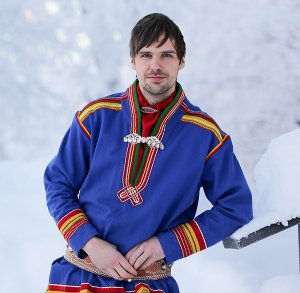
Fredrik Prost, traditional Sami handicraftsman
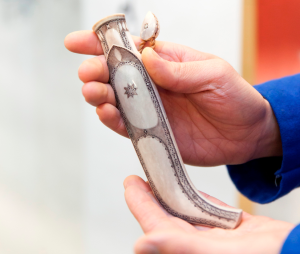
Engraved knife + sheath made from antler, metal
Being of a younger generation and between a traditional lifestyle and a modern one, his working posture included hunching over his work. As a result he had developed upper back pain for which conservative treatment failed to give him relief. He discovered my book, and the pictures and philosophy resonated for him - I was describing things he had seen with his own eyes. So he traveled from his home and workshop in Kiruna, Northern Sweden to attend my June 2014 Gokhale Method Foundations course in Bonn, Germany.
Fredrik was an unusual student - he hip-hinges naturally, his pelvis anteverts, and he has a quiet dignity about him.
During the breaks between classes he shared an anthropology book with me that showed photographs of his grandparents and grand uncles, tallstanding with open chests, hip-hinging with flat backs, and emanating the self-possession and poise that is so characteristic of indigenous people.
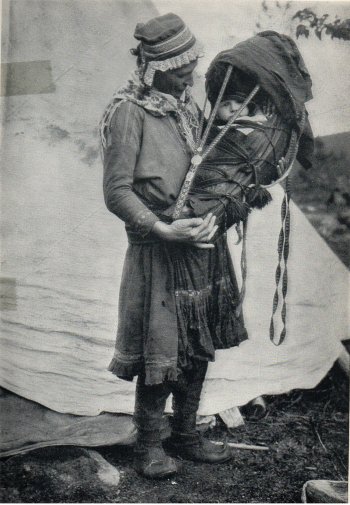
Fredrik's great grandmother Inga-Marja Seva with his grandmother
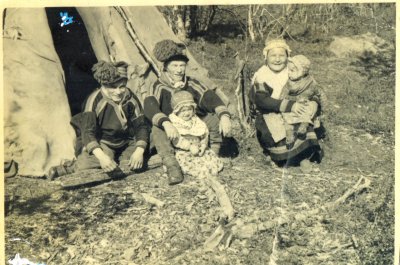
The baby on the right is Fredrik's mother, Ingrid
I was fascinated and we kept in touch through regular Skype meetings. I asked questions about his family, community and the Sami people, getting more intrigued in every conversation. I learned about the kind of tepee his mother was born and raised in (in temperatures that dropped below -55 degrees F), what part of a reindeer’s fur is warmest, how he forges steel for his carved knives, how the Sami dogs know that to attack a human would be their last mistake,... Sensing my interest, Fredrik asked if I would like to visit their community for the marking of the reindeer calves in July (joining a moose hunt in the Fall or counting the calves in the winter might be a tough entry into the culture, he reckoned). And so it has come to be… this summer I will travel to Sapmiland in Northern Sweden for this adventure.
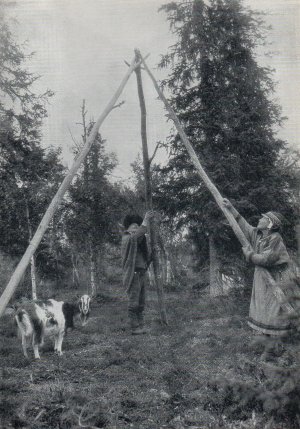
Fredrik's great grandparents Itsa and Susanna Prost
I have several goals for this visit. Of course, I will learn about traditional body ways and movement. I also hope to taste what it means to be rooted in nature, to yoik (traditional singing/chanting) the wind and be the wind,
Note added July 29,2015: Fredrik informed me that videos of this type, created by the Finnish government to promote the tourist industry, is not authentic and is, understandably, problematic for the Sami.
and to live communally without ownership of the land. I want to see and experience what it means when logging companies and mining interests threaten one’s livelihood.
And I would like to figure out how best I can give back to this and other communities from whom I have gotten so much. These people hold alive a treasure for those of us in more modern settings - I know this to be true for musculoskeletal health; I suspect it is also true for other aspects of life.
I will keep you posted as this unfolds.
In a couple of weeks Fredrik departs for Jokkmokk, the Sami winter market held annually since 1605. He will be displaying his art.
Here is a link to his website for those of you who are interested.

Box (birch and reindeer antler)
Best,
Esther
Join us in an upcoming Free Workshop (online or in person).
Find a Foundations Course in your area to get the full training on the Gokhale Method!
We also offer in person or online Initial Consultations with any of our qualified Gokhale Method teachers.

Comments
Fantastic article and
Fantastic article and pictures. Enjoyed your focus on Shamanism and health too. Just a note that Sami are known even in small towns in mid-America. I've passed around a Sami video, Pathfinder; we've had two or three Sami musicians at the music fest over the decades; and there's a new movie next week, very sad and true, Sameblod.
Thanks again. Cynthia
Add New Comment
Login to add commment
Login